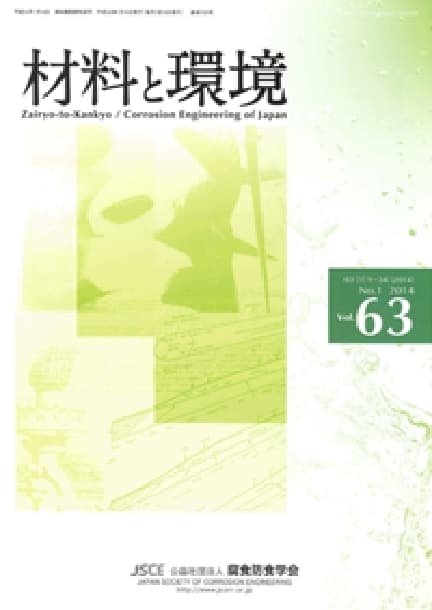- TOP
- Zairyo-to-Kankyo
- Vol. 60 (2011), No. 1
Zairyo-to-Kankyo Vol. 60 (2011), No. 1
Backnumber
-
Vol. 74 (2025)
-
Vol. 73 (2024)
-
Vol. 72 (2023)
-
Vol. 71 (2022)
-
Vol. 70 (2021)
-
Vol. 69 (2020)
-
Vol. 68 (2019)
-
Vol. 67 (2018)
-
Vol. 66 (2017)
-
Vol. 65 (2016)
-
Vol. 64 (2015)
-
Vol. 63 (2014)
-
Vol. 62 (2013)
-
Vol. 61 (2012)
-
Vol. 60 (2011)
-
Vol. 59 (2010)
-
Vol. 58 (2009)
-
Vol. 57 (2008)
-
Vol. 56 (2007)
-
Vol. 55 (2006)
-
Vol. 54 (2005)
-
Vol. 53 (2004)
-
Vol. 52 (2003)
-
Vol. 51 (2002)
-
Vol. 50 (2001)
-
Vol. 49 (2000)
-
Vol. 48 (1999)
-
Vol. 47 (1998)
-
Vol. 46 (1997)
-
Vol. 45 (1996)
-
Vol. 44 (1995)
-
Vol. 43 (1994)
-
Vol. 42 (1993)
-
Vol. 41 (1992)
-
Vol. 40 (1991)
Keyword Ranking
17 Dec. (Last 30 Days)
Zairyo-to-Kankyo Vol. 60 (2011), No. 1
Technological Transition of Corrosion Prevention for Marine Steel Structures
Masami Abe
pp. 3-8
DOI:
10.3323/jcorr.60.3Abstract
Steel is important materials for construction of marine steel structures. However, it has a weak point of corrosion.
Therefore, from old days, countermeasure of corrosion prevention has been working for maintenance of marine steel structures.
This report describes the change of construction and technological transition of corrosion prevention for marine steel structures.
Influence of Residual Rust on Underlying Steel Surface on Performance of Heavy-duty Coating
Masanori Hattori, Atushi Nishikata, Tooru Tsuru
pp. 15-21
DOI:
10.3323/jcorr.60.15Abstract
The influence of the residual rust on the steel surface before applying a heavy-duty coating on the performance was investigated under two accelerated corrosion tests; sunshine weathering meter and immersion tests. The different amounts of the rust were formed on the steel sheets by immersing in NaCl solution for various time periods. They were dried and painted with Polyester-urethane resin of 260 μm thick. The coating degradation and underlying steel corrosion were evaluated by surface observation and electrochemical impedance spectroscopy (EIS). The feasibility of the application of EIS to evaluation of the corrosion performance of the heavy-duty paint was also discussed.
Galvanic Corrosion Behavior between Aluminum and Copper Caused by NaCl Aqueous Solutions
Rongguang Wang, Hiroo Nagano
pp. 22-27
DOI:
10.3323/jcorr.60.22Abstract
In this work, polarization measurement, galvanic current density measurement and spray test were carried out on aluminum (Al), copper (Cu) and Al/Cu couples in NaCl aqueous solutions with different temperatures and different levels of NaCl and aeration. The corrosion current density of Al at 323 K in aerated 1.0 mass% NaCl solution is about 60 times as high as that deaerated with nitrogen, whereas the corrosion current density in aerated 1.0% NaCl solution at 323 K is about 3 times as high as that at 303 K. The corrosion potentials of Al and Cu shifted to negative direction when the NaCl concentration increased from 0.01% to 1.0%. A clear passive region was observed on the Al specimen when the NaCl concentration is below 0.005%. The galvanic current density between the Al/Cu couple increased with the increase in NaCl concentration. In the spray test, the corrosion on the Al side of the Al/Cu couple became more severe with the increase in NaCl concentration and the decrease in the face-to-face distance between Al and Cu.
Investigation of Depassivation-repassivation Behavior of Metal Surfaces Using Micro-indentation Test
Takatoshi Shimada (Yamamoto), Koji Fushimi
pp. 28-38
DOI:
10.3323/jcorr.60.28Abstract
A micro-indentation test was developed to investigate mechano-electochemical properties of metal surfaces. In solution environment, the contact of an indenter with an iron passive surface causes depassivation of the surface when the surface deforms plastically. The scale of the depassivation is dependent on hardness and deformation area of the substrate iron. Repassivation following depassivation is affected by not only electrode potential of the specimen and solution conditions (pH and electric conductivity of the solution) but also dislocation in the substrate iron. Furthermore, the micro-indentation test is useful as a rupture technique of the passive film in order to examine the corrosion resistance of stainless steels. It enables to control the deformation area of metal surfaces at an intentional site in a micrometer-order and to serve an in-situ measurement of electrochemical responses. This technique is suitable for consideration of the mechanism and kinetics of depassivation-repassivation behavior of the surface depending on fine metal structures.
Article Access Ranking
17 Dec. (Last 30 Days)
-
Delayed Fracture Mechanism of 1700 MPa-Class Quenched and Tempered Bolt under Atmospheric Corrosion Environment
Tetsu-to-Hagané Advance Publication
-
Perspectives on the Promising Pathways to Zero Carbon Emissions in the Steel Industry toward 2050
ISIJ International Vol.65(2025), No.2
-
Effect of B on Surface Oxidation Behavior and Phosphatability of Si-Mn-added Cold-Rolled Steel Sheets
ISIJ International Advance Publication
-
Factors Influencing the Bonding Phase Structure of Iron Ore Sinters
ISIJ International Vol.43(2003), No.9
-
Effect of microstructural heterogeneity on fatigue limit of as-quenched low-carbon low-alloy martensitic steel
ISIJ International Advance Publication
-
Prussian blue as a fully reversible hydrogenochromic material for visualizing hydrogen distribution in Fe sheet
ISIJ International Advance Publication
-
Metallurgical Aspects on Interstitial Free Sheet Steel From Industrial Viewpoints
ISIJ International Vol.34(1994), No.1
-
Microstructures and Reduction Properties of High CaO Concentration Sintered Ore
ISIJ International Advance Publication
-
Influence of Antimony on the Oxidation Characteristics of 65Mn Steel
ISIJ International Advance Publication
-
From plasticity to fracture in pearlitic microstructures: Atomistic study of cementite thickness and deformation localization
ISIJ International Advance Publication
You can use this feature after you logged into the site.
Please click the button below.










